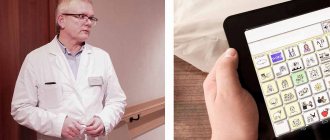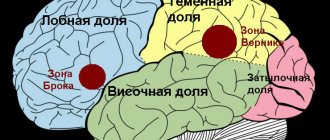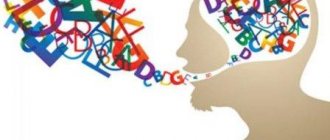Article:
Transient ischemic attacks, stroke and other brain damage can lead to the development of aphasia. The main symptom of this pathology is acquired speech disorders of varying severity. The disease develops as a result of damage to areas of the central nervous system responsible for speech function. Amnestic aphasia is observed when the parietal or temporal region of the cerebral cortex is damaged and is associated with the patient’s inability to name an object while maintaining the ability to describe it. Diagnosis and treatment of pathology is complex. Therapy uses medications, as well as long-term speech and social rehabilitation.
About the disease and its classification
Aphasia is manifested by speech impairment as a result of organic damage to nervous tissue in various parts of the brain. The localization of the damaged area determines the clinical manifestations of the disease. Based on the nature of the speech disorder, neurologist A.R. Luria identified several types of aphasia:
- Motor, which is further divided into efferent and afferent. Appears when the pre- and postcentral gyri are damaged. Characterized by difficulties in selecting the correct sounds and disruption of the motor articulation process.
- Sensory, manifested by a violation of the perception of the speech of others and one’s own, as a result of which it becomes illegible and ungrammatical. Develops in patients with damage to Wernicke's center.
- Acoustic-mnestic occurs in patients with damage to the fibers connecting the hippocampus, responsible for memory, with the auditory cortex. The patients' speech is poor, with a large number of omissions of nouns and paraphrases.
- Semantic aphasia occurs when the frontal areas of the cerebral cortex are damaged. A person stops understanding complex grammatical structures and begins to use simple sentences in his speech.
- Amnestic, characterized by the patient’s inability to name a specific object. Occurs with damage to the temporal and parietal parts of the brain.
Amnestic aphasia occurs in 5-10% of patients with damage to the cerebral cortex. The disease leads to a decrease in the level of quality of life due to difficulty communicating with other people. In addition, difficulties arise in the patient’s professional life and the likelihood of loss of ability to work.
Speech apparatus device
The functioning of the nervous system of the human brain is designed in such a way that we do not have to think every second about every action we take. Most parts of the central nervous system operate autonomously, i.e. independent mode and all this thanks to millions of electrochemical connections both between individual neurons and between higher nerve centers. The speech apparatus of an adult consists of several centers and is a complex structure that, thanks to nerve connections, functions as a single whole. The main role in the development and activation of speech function is played by the brain speech and analytical centers of Wernicke and Broca.
Main reasons
The occurrence of amnestic aphasia is observed when the brain is exposed to any damaging factors. It should be noted that for right-handed people to experience symptoms, the damage must be localized in the left hemisphere, while for left-handed people the opposite is true. The main causes of organic changes in the central nervous system include:
- traumatic brain injuries occurring as a result of a traffic accident or a direct blow to the temporal or parietal region (such an impact causes mechanical damage to the nervous tissue);
- encephalitis and meningitis, characterized by the development of purulent or serous inflammation and destruction of nerve cells, as well as their fibers (observed with bacterial, viral or fungal infection);
- benign or malignant tumors with intracranial localization;
- surgical interventions performed in the area of the temporal and parietal cortex (when removing tumors, vascular aneurysms and other formations, damage to the functional cortical areas responsible for speech is possible);
- transient ischemic attacks and strokes of any type, manifested by necrosis of certain areas of the cerebral cortex;
- acute intoxication with poisons and drugs (similar changes develop against the background of liver and kidney failure, due to the accumulation of toxic metabolic products in the blood);
- neurodegenerative diseases - Pick's disease and Alzheimer's disease, characterized by the gradual destruction of neurons in the cerebral cortex.
In addition to these reasons, there are predisposing factors to the development of amnestic aphasia. These include hereditary predisposition and old age.
What is amnestic aphasia?
Aphasia is a neurological disease of organic nature, which is formed as a result of the death of neurons located in the cerebral cortex area, responsible for the synthesis and formation of speech function, as well as the perception of speech and non-verbal signals of surrounding people. Aphasia is always an acquired pathology, i.e. it is observed in people with initially normally functioning speech function, so it is important not to confuse aphasia with alalia if the disease is observed in childhood.
A wide range of reasons can lead to the development of pathology, but the final pathogenetic mechanism of this disease is the same and consists in extensive death of nervous tissue localized in specific areas of the brain responsible for speech.
Clinical manifestations
Symptoms of amnestic aphasia develop slowly, and therefore the patient himself and his loved ones may not be aware of the disease for a long time. The periodic inability to name an object is often associated with a person's age, which leads to a late diagnosis. The main clinical manifestations include the following clinical signs:
- a person cannot name an object, however, he can easily describe its external characteristics and purpose;
- due to the difficulty of selecting the names of things, the patient’s speech is slow and has a large number of pauses (the opposite situation may be observed - fluent speech with frequent errors in the use of words);
- repetition of the same words and phrases (typically a large number of descriptive constructions and paraphrases);
- the number of nouns decreases (most often, speech consists of adjectives that describe an object);
- speech is logical and grammatically correct;
- reading and writing skills do not suffer and remain at the same level;
- the pronunciation of sounds and their combinations does not change;
- articulation changes are not detected.
Amnestic aphasia is characterized by the inability to retain the name of an object. As a result, the patient uses complex descriptive constructions consisting mainly of adjectives. It is this feature of speech that allows one to suspect a disease and seek medical help.
Advantages of visiting the Yusupov Hospital
Treatment of aphasia of various forms in Moscow is carried out by experienced specialists from the neurological department of the Yusupov Hospital. By trusting us with your health, you can be sure of receiving qualified medical care. Each patient is guaranteed an individual approach. In their work, doctors use proven modern techniques, which ensures a positive result of therapy.
Despite the high quality of services provided, prices are affordable (more details on the price list can be found on the website). In addition to neurology, services are available in other areas, including oncology, surgery, and therapy. For convenience, payment for treatment can be made in cash or by bank transfer. To make an appointment with a specialist, just call the numbers provided or fill out an application online, leaving your contact information.
Diagnostic measures
Diagnostics and treatment are handled by two specialists - a psychiatrist and a neurologist. Under no circumstances should you make a diagnosis or select therapy on your own. This can cause rapid progression of the underlying disease and the development of its complications. In medical institutions, the patient is examined according to the following algorithm:
- The patient's complaints, as well as anamnesis of life and illness, are collected. The specialist identifies factors and possible causes of brain damage. In most cases, it is necessary to additionally talk with loved ones.
- General clinical examinations: general and biochemical blood tests, general urinalysis, electrocardiogram, etc.
- Due to the presence of cognitive impairment, all patients are prescribed neuropsychological diagnostics based on the study of memory, attention, ability to perceive information, etc. Such methods make it possible to clarify the nature of the speech disorder, as well as to suggest the localization of the lesion in the brain.
- Computed or magnetic resonance imaging is used to study the structures of the central nervous system. The doctor has the opportunity to assess their integrity and identify areas of damage to the nervous tissue.
- If a traumatic brain injury is suspected, an X-ray examination of the skull is performed. The method allows you to identify damage to bone structures that indicate a head injury.
- In the case of neuroinfections, an enzyme-linked immunosorbent assay (ELISA) or polymerase chain reaction (PCR) of the patient’s blood and cerebrospinal fluid is performed to identify the pathogenic microorganism.
- Ultrasound and Doppler mapping of the cervical and cerebral vessels are used if symptoms are suspected of being ischemic. During the examination, the doctor can determine narrowing of the arteries, the formation of aneurysms, malformations, etc.
An integrated approach to diagnostics allows us to determine the exact location of brain damage and make an accurate diagnosis.
Diagnostics
Amnestic aphasia is a disease that lies at the intersection of two areas: neurology and psychology. Since aphasia is characterized by various disorders of the cognitive function of the brain, such disorders cannot but be accompanied by mental defects. Neuropsychological diagnostic methods are used to identify amnestic aphasia. To verify the disease and clarify the degree of impairment of the functional activity of the speech apparatus of a sick person, they resort to the use of special tests. Typically, such tests use a variety of objects with varying degrees of difficulty in pronouncing their names. There are also tests of a descriptive nature, when the patient is told about the characteristics of an object and see if the patient can answer with hints. A number of tests determine the connection between speech and visual manifestations, for example, the patient is sequentially shown several objects belonging to the same category; if the patient does not respond, then he has a violation of the connection between speech function and visual images, which can be interpreted in favor of sensory-amnestic aphasia.
In addition to special neurological and psychological tests, each patient is required to undergo laboratory and instrumental research methods. Depending on the cause of aphasia, diagnostic methods will be more or less informative.
The Clinical Brain Institute has a high-tech diagnostic department, which can conduct research such as:
- Tomographic studies: computed tomography and magnetic resonance imaging with and without contrast;
- X-ray examination of the skull and brain to identify defects;
- Ultrasound sonography and Doppler mapping of neck vessels;
- Comprehensive laboratory diagnostics.
In addition to high-quality equipment, a specialist is no less important for diagnostic purposes. The diagnostic department employs highly qualified specialists certified in related fields of medicine, which increases the efficiency of the diagnostic search and subsequent treatment of each individual patient.
Effective treatment
The main goal of therapy is to eliminate the underlying factor that led to the development of the disease. If tumor formations, hematomas and other space-occupying structures are detected, the patient is indicated for neurosurgical intervention with their removal. For neuroinfections, etiotropic therapy is prescribed - antibacterial, antifungal or antiviral drugs.
Treatment of amnestic aphasia and elimination of its symptoms includes medicinal and non-medicinal types of treatment. The following drugs are chosen among the medicines:
- nootropics (Phenotropil, Piracetam, etc.), which improve metabolism in the nervous tissue and help improve cognitive functions;
- medications that improve cerebral circulation: Actovegin, Cerebrolysin and their analogues (increase the delivery of nutrients and oxygen through the blood to the cerebral cortex, which has a positive effect on a person’s cognitive skills).
Any medications should only be prescribed by a doctor. All medications have a number of contraindications for their use, which should be taken into account when selecting treatment. Otherwise, the patient may experience side effects from the medications. In addition to medication, methods of non-invasive brain stimulation using magnetic fields or weak electric current are used. Such procedures improve the functioning of nervous tissue and improve cognitive skills.
Rehabilitation activities
Correct and comprehensive rehabilitation is of greatest importance in the correction of amnestic aphasia. Training aimed at restoring speech and other skills takes place in several stages:
- First, the patient is taught to work with objects through their visual image. To do this, use cards with an image and its name. This allows you to associate a certain visual image of an object and function with its name.
- At the second stage, the emphasis in rehabilitation is on the restoration of situationally determined speech. The patient is given a set of classes, including on-site orientation with verbal instructions from a specialist, and discussion of various everyday topics. To consolidate the results obtained, self-testing, questionnaires and classes with rehabilitation specialists are carried out.
- The last stage is aimed at improving visual and auditory-verbal memory. The patient is asked to solve crosswords and riddles, retell passages from books or conversations, and write stories. Conduct classes to improve factual memory by remembering important dates, addresses and other information. Communication with loved ones is important, since active speech and its perception help the patient restore the functions of various parts of the brain.
In addition to these activities, all patients need constant work activity, reading books and attending physical therapy classes. The rehabilitation process lasts from several months to several years, depending on the severity of the brain damage.
Remember all!
Disturbances in amnestic aphasia require coordinated work of a team of doctors and defectologists. The baby’s family also needs to get involved. The main thing is to do it right. After all, the task is to build new connections to replace the lost ones, which means that you won’t achieve much by simple repetition. The image of an object is made up of a set of factors, and the task of adults is to connect as many of the child’s sensations as possible. Is the baby unable to remember the word “spoon” because the connection between the visual image and the name of the object is broken? It doesn’t matter, because you can use a spoon:
- touch,
- twirl in your hands
- lick
- listen to her fall to the floor
- smell.
One of the familiar sensations may well turn out to be the key to a forgotten word and will tell specialists possible ways of rehabilitation. The child’s brain is plastic, and when the cause of forgetting words is eliminated, it builds up new connections quite quickly. Especially if you give it support in the form of a dosed load, which will stimulate the activity of various zones.
How to prevent the development of the disease
Prevention of amnestic aphasia is based on preventive measures that cause damage to the structures of the central nervous system. This includes the following medical recommendations:
- avoid situations that can lead to traumatic brain injuries (use a helmet and other protective equipment when engaging in hazardous sports);
- if you have a disease of the cardiovascular system or other internal organs, follow the doctor’s instructions and do not self-medicate;
- after neurosurgical operations, undergo full rehabilitation measures aimed at restoring cognitive skills;
- regularly engage in sports, including aerobic exercise and strength training;
- eliminate bad habits - drinking alcohol and smoking;
- normalize the diet by excluding from it all fatty, salty, smoked foods, and increasing the proportion of lean meats (chicken, rabbit), fish, fruits, vegetables and berries;
- in old age, continue to read books, learn poetry, do handicrafts and other hobbies (such activities prevent the development of Alzheimer's disease and Pick's disease).
If you detect any signs of amnestic aphasia in yourself or a close relative, you should immediately seek medical help. The pathology is treated by a neurologist or psychiatrist. In the absence of these specialists, it is necessary to visit a therapist who will conduct an initial diagnosis and refer the patient for further consultation to specialized medical institutions.
The prognosis depends on the degree of damage to the nerve tissue and the time of initiation of treatment and rehabilitation. With a small affected area and early initiation of therapy, the patient gradually recovers normal speech and other cognitive skills. If treatment is started late, its effectiveness is limited. Residual speech defects of varying severity are possible. The support of loved ones who are directly involved in the rehabilitation of the patient is important in eliminating aphasia.
Rehabilitation
Only daily classes with a speech therapist and other specialists will contribute to an active rehabilitation process. It is very important to correctly build a rehabilitation plan from simple to complex. To begin with, the victim must be adapted to new conditions. Only after a course of psychotherapy can one begin rehabilitation measures, since the patient must be motivated to recover.
The patient can also perform the following exercises at home:
- Simple questions: the patient is first asked questions with monosyllabic yes or no answers, then later they move on to open questions.
- Thematic dialogues are practiced with the gradual development of dialogue on specific topics;
- Writing and reading. Correction of the spelling and pronunciation of letters begins. Then syllables, which the patient then puts into words. In the future, with successful progress, they move on to writing dictations and reading short texts. The patient is asked to retell in his own words the story he read and answer questions about its content;
- A task aimed at matching pictures and text. The patient is asked to build a story, while laying out the pictures sequentially;
- Structuring pictures according to general properties and characteristics. The patient is given the task of arranging the pictures according to categories and highlighting common characteristics, for example, to separate some animals from others.







